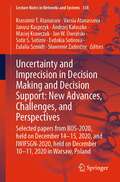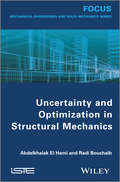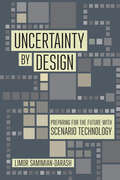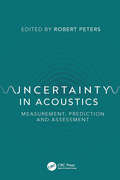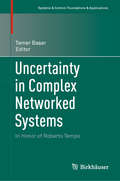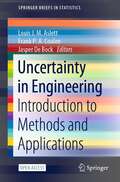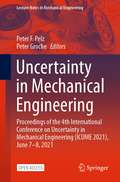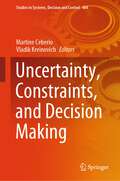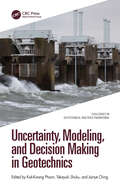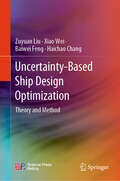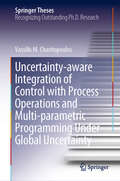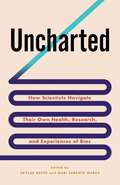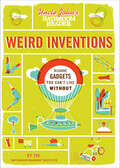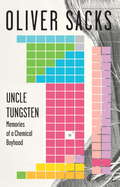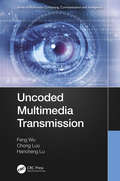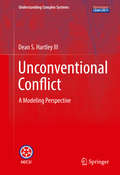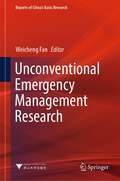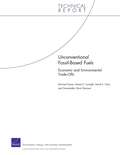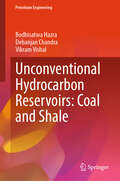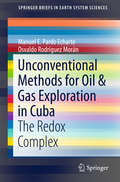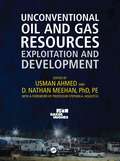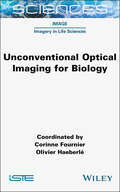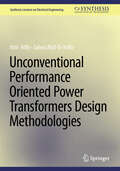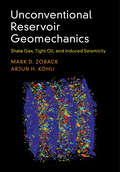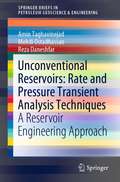- Table View
- List View
Uncertainty and Imprecision in Decision Making and Decision Support: Selected papers from BOS-2020, held on December 14-15, 2020, and IWIFSGN-2020, held on December 10-11, 2020 in Warsaw, Poland (Lecture Notes in Networks and Systems #338)
by Krassimir T. Atanassov Janusz Kacprzyk Sławomir Zadrożny Jan W. Owsiński Maciej Krawczak Evdokia Sotirova Eulalia Szmidt Andrzej Kałuszko Vassia Atanassova Sotir S. SotirovThis book is composed of selected papers from the Sixteenth National Conference on Operational and Systems Research, BOS-2020, held on December 14-15, 2020, one of premiere conferences in the field of operational and systems research. The second is the Nineteenth International Workshop on Intuitionistic Fuzzy Sets and Generalized Nets, IWIFSGN 2020, held on December 10-11, 2020, in Warsaw, Poland, in turn—one of premiere conferences on fuzzy logic, notably on extensions of the traditional fuzzy sets, also comprising a considerable part on the generalized nets (GNs), an important extension of the traditional Petri nets. A joint publication of selected papers from the two conferences follows a long tradition of such a joint organization and—from a substantial point of view—combines systems modeling, systems analysis, broadly perceived operational research, notably optimization, decision making, and decision support, with various aspects of uncertain and imprecise information and their related tools and techniques.
Uncertainty and Optimization in Structural Mechanics (Focus Ser.)
by Bouchaib Radi Abdelkhalak El HamiOptimization is generally a reduction operation of a definite quantity. This process naturally takes place in our environment and through our activities. For example, many natural systems evolve, in order to minimize their potential energy. Modeling these phenomena then largely relies on our capacity to artificially reproduce these processes. In parallel, optimization problems have quickly emerged from human activities, notably from economic concerns. This book includes the most recent ideas coming from research and industry in the field of optimization, reliability and the recognition of accompanying uncertainties. It is made up of eight chapters which look at the reviewing of uncertainty tools, system reliability, optimal design of structures and their optimization (of sizing, form, topology and multi-objectives) – along with their robustness and issues on optimal safety factors. Optimization reliability coupling will also be tackled in order to take into account the uncertainties in the modeling and resolution of the problems encountered. The book is aimed at students, lecturers, engineers, PhD students and researchers. Contents 1. Uncertainty. 2. Reliability in Mechanical Systems. 3. Optimal Structural Design. 4. Multi-object Optimization with Uncertainty. 5. Robust Optimization. 6. Reliability Optimization. 7. Optimal Security Factors Approach. 8. Reliability-based Topology Optimization. About the Authors Abdelkhalak El Hami is Professor at the Institut National des Sciences Appliquées, Rouen, France. He is the author of many articles and books on optimization and uncertainty. Bouchaib Radi is Professor in the Faculty of Sciences and Technology at the University of Hassan Premier, Settat, Morocco. His research interests are in such areas as structural optimization, parallel computation, contact problem and metal forming. He is the author of many scientific articles and books.
Uncertainty by Design: Preparing for the Future with Scenario Technology (Expertise: Cultures and Technologies of Knowledge)
by Limor Samimian-DarashIn Uncertainty by Design Limor Samimian-Darash presents cases of the use of scenario technology in the fields of security and emergency preparedness, energy, and health by analyzing scenario narratives and practices at the National Emergency Management Authority in Israel, the World Health Organization's Regional Office for Europe, and the World Energy Council. Humankind has long struggled with the uncertainty of the future, with how to foresee the future, imagine alternatives, or prepare for and guard against undesirable eventualities. Scenario—or scenario planning—emerged in recent decades to become a widespread means through which states, large corporations, and local organizations imagine and prepare for the future. The scenario technology cases examined in Uncertainty by Design provide a useful lens through which to view contemporary efforts to engage in an overall journey of discovering the future, along with the modality of governing involved in these endeavors to face future uncertainties. Collectively, they enable us to understand in depth how scenarios express a new governing modality.
Uncertainty in Acoustics: Measurement, Prediction and Assessment
by Robert PetersThis guide to estimating uncertainties in the measurement, prediction and assessment of noise and vibration applies across environmental noise and vibration, occupational noise and vibration exposure, and building and architectural acoustics. The book collates information from the various Standards and from research, with explanation, examples and case studies. It enables estimation of uncertainty in the measurement and prediction of acoustic quantities, suitable for use in environmental impact and occupational exposure assessments. It is for acoustic consultants, mechanical and building service engineers, architect and building professionals and environmental health officers. Bob Peters worked for more than forty years in acoustics and noise control – teaching, research, consultancy. He was a principal acoustic consultant with Applied Acoustic Design, a senior research fellow at London South Bank University, and a tutor on Institute of Acoustics distance learning courses.
Uncertainty in Complex Networked Systems: In Honor of Roberto Tempo (Systems & Control: Foundations & Applications)
by Tamer BaşarThe chapters in this volume, and the volume itself, celebrate the life and research of Roberto Tempo, a leader in the study of complex networked systems, their analysis and control under uncertainty, and robust designs. Contributors include authorities on uncertainty in systems, robustness, networked and network systems, social networks, distributed and randomized algorithms, and multi-agent systems—all fields that Roberto Tempo made vital contributions to. Additionally, at least one author of each chapter was a research collaborator of Roberto Tempo’s.This volume is structured in three parts. The first covers robustness and includes topics like time-invariant uncertainties, robust static output feedback design, and the uncertainty quartet. The second part is focused on randomization and probabilistic methods, which covers topics such as compressive sensing, and stochastic optimization. Finally, the third part deals with distributed systems and algorithms, and explores matters involving mathematical sociology, fault diagnoses, and PageRank computation.Each chapter presents exposition, provides new results, and identifies fruitful future directions in research. This book will serve as a valuable reference volume to researchers interested in uncertainty, complexity, robustness, optimization, algorithms, and networked systems.
Uncertainty in Engineering: Introduction to Methods and Applications (SpringerBriefs in Statistics)
by Frank P. A. Coolen Louis J. M. Aslett Jasper De BockThis open access book provides an introduction to uncertainty quantification in engineering. Starting with preliminaries on Bayesian statistics and Monte Carlo methods, followed by material on imprecise probabilities, it then focuses on reliability theory and simulation methods for complex systems. The final two chapters discuss various aspects of aerospace engineering, considering stochastic model updating from an imprecise Bayesian perspective, and uncertainty quantification for aerospace flight modelling. Written by experts in the subject, and based on lectures given at the Second Training School of the European Research and Training Network UTOPIAE (Uncertainty Treatment and Optimization in Aerospace Engineering), which took place at Durham University (United Kingdom) from 2 to 6 July 2018, the book offers an essential resource for students as well as scientists and practitioners.
Uncertainty in Mechanical Engineering: Proceedings of the 4th International Conference on Uncertainty in Mechanical Engineering (ICUME 2021), June 7–8, 2021 (Lecture Notes in Mechanical Engineering)
by Peter Groche Peter F. PelzThis open access book reports on methods and technologies to describe, evaluate and control uncertainty in mechanical engineering applications. It brings together contributions by engineers, mathematicians and legal experts, offering a multidisciplinary perspective on the main issues affecting uncertainty throughout the complete system lifetime, which includes process and product planning, development, production and usage. The book is based on the proceedings of the 4th International Conference on Uncertainty in Mechanical Engineering (ICUME 2021), organized by the Collaborative Research Center (CRC) 805 of the TU Darmstadt, and held online on June 7–8, 2021. All in all, it offers a timely resource for researchers, graduate students and practitioners in the field of mechanical engineering, production engineering and engineering optimization.
Uncertainty, Constraints, and Decision Making (Studies in Systems, Decision and Control #484)
by Vladik Kreinovich Martine CeberioIn the first approximation, decision making is nothing else but an optimization problem: We want to select the best alternative. This description, however, is not fully accurate: it implicitly assumes that we know the exact consequences of each decision, and that, once we have selected a decision, no constraints prevent us from implementing it. In reality, we usually know the consequences with some uncertainty, and there are also numerous constraints that needs to be taken into account. The presence of uncertainty and constraints makes decision making challenging. To resolve these challenges, we need to go beyond simple optimization, we also need to get a good understanding of how the corresponding systems and objects operate, a good understanding of why we observe what we observe – this will help us better predict what will be the consequences of different decisions. All these problems – in relation to different application areas – are the main focus of this book.
Uncertainty, Modeling, and Decision Making in Geotechnics
by Kok-Kwang Phoon, Takayuki Shuku, and Jianye ChingUncertainty, Modeling, and Decision Making in Geotechnics shows how uncertainty quantification and numerical modeling can complement each other to enhance decision-making in geotechnical practice, filling a critical gap in guiding practitioners to address uncertainties directly. The book helps practitioners acquire a working knowledge of geotechnical risk and reliability methods and guides them to use these methods wisely in conjunction with data and numerical modeling. In particular, it provides guidance on the selection of realistic statistics and a cost-effective, accessible method to address different design objectives, and for different problem settings, and illustrates the value of this to decision-making using realistic examples. Bringing together statistical characterization, reliability analysis, reliability-based design, probabilistic inverse analysis, and physical insights drawn from case studies, this reference guide from an international team of experts offers an excellent resource for state-of-the-practice uncertainty-informed geotechnical design for specialist practitioners and the research community.
Uncertainty-Based Ship Design Optimization: Theory and Method
by Xiao Wei Zuyuan Liu Baiwei Feng Haichao ChangThe book focused on the basic bottleneck issues in the ship uncertainty-based design optimization. Based on the concepts of robustness and reliability design, uncertainty classification, uncertainty modeling, uncertainty analysis and propagation methods were systematically explained, revealing the influence mechanism and rules of multi-source aleatory and epistemic uncertainty on ship design. Finally, a hull form design optimization method with mixed uncertainty was established. The theory of uncertainty design optimization is not yet mature, and this book gives a detailed introduction. The illustrations and tables in this book compared the differences between uncertainty-based optimization and traditional deterministic optimization, reflecting the advantages of uncertainty optimization. This book will be a useful reference for researchers and engineers in the field of ship design.
Uncertainty-aware Integration of Control with Process Operations and Multi-parametric Programming Under Global Uncertainty (Springer Theses)
by Vassilis M. CharitopoulosThis book introduces models and methodologies that can be employed towards making the Industry 4.0 vision a reality within the process industries, and at the same time investigates the impact of uncertainties in such highly integrated settings. Advances in computing power along with the widespread availability of data have led process industries to consider a new paradigm for automated and more efficient operations. The book presents a theoretically proven optimal solution to multi-parametric linear and mixed-integer linear programs and efficient solutions to problems such as process scheduling and design under global uncertainty. It also proposes a systematic framework for the uncertainty-aware integration of planning, scheduling and control, based on the judicious coupling of reactive and proactive methods. Using these developments, the book demonstrates how the integration of different decision-making layers and their simultaneous optimisation can enhance industrial process operations and their economic resilience in the face of uncertainty.
Uncharted: How Scientists Navigate Their Own Health, Research, and Experiences of Bias
by Skylar Bayer Gabriela Serrato MarksPeople with disabilities are underrepresented in STEM fields, and all too often, they face isolation and ableism in academia. Uncharted is a collection of powerful first-person stories by current and former scientists with disabilities or chronic conditions who have faced changes in their careers, including both successes and challenges, because of their health. It gives voice to common experiences that are frequently overlooked or left unspoken. These deeply personal accounts describe not only health challenges but also the joys, sorrows, humor, and wonder of science and scientists.With a breadth of perspectives on being disabled or chronically ill, these stories highlight the intersectionality of minoritized identities with the disability community. Uncharted features essays by contributors who are d/Deaf, blind, neurodivergent, wheelchair users, have experienced traumatic brain injuries, have blood sugar disorders, have rare medical diagnoses, or have received psychiatric diagnoses, among many others. In many cases, the scientific field is not fully accessible to them, and they frankly describe struggling as well as thriving alongside their conditions.This book serves as representation for scientists who have never felt comfortable disclosing their disability or who have never felt fully understood. The stories shared in this book seek to normalize medical conditions and disabilities in scientific culture, offering recommendations for how and why to improve access. Uncharted is vital and compelling reading for current and aspiring scientists who want to make their fields more inclusive and supportive for everyone.
Uncle John's Bathroom Reader Weird Inventions: Bizarre Gadgets You Can't Live Without (Uncle John's Bathroom Reader)
by Bathroom Readers' InstituteThe writers behind Uncle John's Bathroom Reader present this totally true treasury of amazing gizmos--devilish devices you never knew existed, created by people who thought the world absolutely needed what they had to offer and sell.Read all about:- The onesie that turns your crawling baby into a mop- The fart-stifling blanket- The square watermelon- The video game you control with your mind- The weight loss device that sucks food out of your stomach
Uncle Tungsten: Memories of a Chemical Boyhood
by Oliver SacksLong before Oliver Sacks became a distinguished neurologist and bestselling writer, he was a small English boy fascinated by metals–also by chemical reactions (the louder and smellier the better), photography, squids and cuttlefish, H.G. Wells, and the periodic table. In this endlessly charming and eloquent memoir, the author of The Man Who Mistook His Wife for a Hat and Awakenings chronicles his love affair with science and the magnificently odd and sometimes harrowing childhood in which that love affair unfolded.In Uncle Tungsten we meet Sacks’ extraordinary family, from his surgeon mother (who introduces the fourteen-year-old Oliver to the art of human dissection) and his father, a family doctor who imbues in his son an early enthusiasm for housecalls, to his “Uncle Tungsten,” whose factory produces tungsten-filament lightbulbs. We follow the young Oliver as he is exiled at the age of six to a grim, sadistic boarding school to escape the London Blitz, and later watch as he sets about passionately reliving the exploits of his chemical heroes–in his own home laboratory. Uncle Tungsten is a crystalline view of a brilliant young mind springing to life, a story of growing up which is by turns elegiac, comic, and wistful, full of the electrifying joy of discovery.
Uncoded Multimedia Transmission (Multimedia Computing, Communication and Intelligence)
by Feng Wu Chong Luo Hancheng LuAn uncoded multimedia transmission (UMT) system is one that skips quantization and entropy coding in compression and all subsequent binary operations, including channel coding and bit-to-symbol mapping of modulation. By directly transmitting non-binary symbols with amplitude modulation, the uncoded system avoids the annoying cliff effect observed in the coded transmission system. This advantage makes uncoded transmission more suited to both unicast in varying channel conditions and multicast to heterogeneous users. Particularly, in the first part of Uncoded Multimedia Transmission, we consider how to improve the efficiency of uncoded transmission and make it on par with coded transmission. We then address issues and challenges regarding how to better utilize temporal and spatial correlation of images and video in the uncoded transmission, to achieve the optimal transmission performance. Next, we investigate the resource allocation problem for uncoded transmission, including subchannel, bandwidth and power allocation. By properly allocating these resources, uncoded transmission can achieve higher efficiency and more robust performance. Subsequently, we consider the image and video delivery in MIMO broadcasting networks with diverse channel quality and varying numbers of antennas across receivers. Finally, we investigate the cases where uncoded transmission can be used in conjunction with digital transmission for a balanced efficiency and adaptation capability. This book is the very first monograph in the general area of uncoded multimedia transmission written in a self-contained format. It addresses both the fundamentals and the applications of uncoded transmission. It gives a systematic introduction to the fundamental theory and concepts in this field, and at the same time, also presents specific applications that reveal the great potential and impacts for the technologies generated from the research in this field. By concentrating several important studies and developments currently taking place in the field of uncoded transmission in a single source, this book can reduce the time and cost required to learn and improve skills and knowledge in the field. The authors have been actively working in this field for years, and this book is the final essence of their years of long research in this field. The book may be used as a collection of research notes for researchers in this field, a reference book for practitioners or engineers, as well as a textbook for a graduate advanced seminar in this field or any related fields. The references collected in this book may be used as further reading lists or references for the readers.
Unconventional Conflict: A Modeling Perspective (Understanding Complex Systems)
by Dean S. Hartley IIIThis book describes issues in modeling unconventional conflict and suggests a new way to do the modeling. It presents an ontology that describes the unconventional conflict domain, which allows for greater ease in modeling unconventional conflict. Supporting holistic modeling, which means that we can see the entire picture of what needs to be modeled, the ontology allows us to make informed decisions about what to model and what to omit. The unconventional conflict ontology also separates the things we understand best from the things we understand least. This separation means that we can perform verification, validation and accreditation (VV&A) more efficiently and can describe the competence of the model more accurately.However, before this message can be presented in its entirety the supporting body of knowledge has to be explored. For this reason, the book offers chapters that focus on the description of unconventional conflict and the analyses that have been performed, modeling, with a concentration on past efforts at modeling unconventional conflict, the precursors to the ontology, and VV&A. Unconventional conflict is a complex, messy thing. It normally involves multiple actors, with their own conflicting agendas and differing concepts of legitimate actions. This book will present a useful introduction for researchers and professionals within the field.
Unconventional Emergency Management Research (Reports of China’s Basic Research)
by Weicheng FanThis book mainly introduces the research overview, research results and follow-up prospects of “Unconventional Emergency Management Research”, a major research plan of National Natural Science Foundation of China (hereinafter referred to as the Plan). The Plan has carried out innovative research around major strategic fields and directions on emergency management. A total of 121 projects were funded by the Plan, including 92 Fostering Projects, 25 Key Projects and 4 Integrated Projects, with a total funding of 120 million RMB. From the perspective of major national needs and scientific discipline development, the book focuses on three key scientific issues: information processing and evolution modeling of unconventional emergencies, emergency decision-making theory of unconventional emergencies, and psychological and behavioral response laws of individuals and groups in emergency situations. The publication of this book aims to provide more powerful support for the research and exploration in public security and emergency management.
Unconventional Fossil-Based Fuels
by David S. Ortiz Michael Toman Aimee E. Curtright Joel Darmstadter Brian ShannonIn this report, RAND researchers assess the potential future production levels, production costs, greenhouse gases, and other environmental implications of synthetic crude oil from oil sands and fuels produced via coal liquefaction relative to conventional petroleum-based transportation fuels. The findings indicate the potential cost-competitiveness of these alternative fuels and potential economic-environmental trade-offs from their deployment.
Unconventional Hydrocarbon Reservoirs: Coal and Shale (Petroleum Engineering)
by Bodhisatwa Hazra Debanjan Chandra Vikram VishalThis informative book offers a comprehensive exploration of critical reservoir parameters, including quantification techniques and interpretations for evaluating these reservoirs. Readers will also gain insight into the fundamental principles of simulating gas production from coal and shale reservoirs, as well as the key input parameters for building the best-fit reservoir model. Additionally, the book explores various aspects of storing captured CO2 in these reservoirs and their potential role in preventing global temperature increases beyond pre-industrial levels.Energy from conventional petroleum reservoirs and coal has been the backbone of global energy needs for a long time. However, depletion of these fossil fuel reserves, as well as their contribution to rising greenhouse emissions, has prompted a shift to renewable energy sources. Natural gas found in unconventional coal and shale reservoirs is increasingly seen as a greener energy option, emitting approximately 45% less CO2 than conventional sources. Furthermore, due to their vast availability and capacity to sequester atmospheric CO2, unconventional coal and shale reservoirs can facilitate the transition to renewable energy resources.With a focus on achieving temperature stabilization at 1.5°C, this book offers a valuable resource for those interested in renewable energy and mitigating climate change.
Unconventional Methods for Oil & Gas Exploration in Cuba
by Manuel E. Pardo Echarte Osvaldo Rodríguez MoránThis book studies the "Redox Complex", a complex of unconventional geophysical-geochemical exploration techniques used for the indirect detection, characterization and evaluation of various metal targets, while also illustrating selected applications of unconventional geophysical-geochemical methods for oil exploration in Cuba. This complex is successfully applied in various fields: oil & gas and metal ores exploration; studies of oil and metal contaminants in soils; and the search for metallic archaeological burials. The use of these techniques is intended to complement the conventional prospecting complex by reducing areas and/or facilitating the selection of the most favorable targets, improving the economical-geological effectiveness of investigations in the process. Further, the Redox Complex can be implemented without physical or chemical damage to the environment. The book's primary goals are to: 1) outline the general features characterizing the processes of metal mobilization, transport and accumulation on surficial media; 2) outline the methodology, data interpretation and mathematical apparatus that support quantitative estimates of the Redox Complex; and 3) design a database and applications system (the Redox System) to address storage processes, reports, graphics and the corresponding interpretations of the Redox Complex in a quick and reliable way. To do so, it examines the regions of Havana-Matanzas (Varadero Oil Field, Cantel Oil Field and Madruga Prospect) and Ciego de Ávila (Pina Oil Field, Cristales Oil Field, Jatibonico Oil Field, Jatibonico Oeste Prospect and Cacahual Prospect). The methods covered include, in some cases, airborne gamma spectrometry (K/eTh ratio) beside ORP and, in others, the Redox Complex with reduced or standard attributes. In all cases, the anomalous complex of interest corresponds to the correlation of the minimum K/eTh ratio with minimum ORP and, in the case of the Redox Complex, Magnetic Susceptibility highs with ORP lows, Spectral Reflectance lows and maximum Content of Chemical Elements (V, Ni, Pb, Zn, Fe).
Unconventional Oil and Gas Resources: Exploitation and Development (Emerging Trends and Technologies in Petroleum Engineering)
by Usman Ahmed D. Nathan MeehanAs the shale revolution continues in North America, unconventional resource markets are emerging on every continent. In the next eight to ten years, more than 100,000 wells and one- to two-million hydraulic fracturing stages could be executed, resulting in close to one trillion dollars in industry spending. This growth has prompted professionals ex
Unconventional Optical Imaging for Biology
by Corinne Fournier Olivier HaeberléOptical imaging of biological systems has undergone spectacular development in recent years, producing a quantity and a quality of information that, just twenty years ago, could only be dreamed of by physicists, biologists and physicians. Unconventional imaging systems provide access to physical quantities – phase, absorption, optical index, the polarization property of a wave or the chemical composition of an object – not accessible to conventional measurement systems. To achieve this, these systems use special optical setups and specific digital image processing to reconstruct physical quantities. This field is also known as computational imaging. This book presents various non-conventional imaging modalities developed for the biomedical field: wave front analysis imaging, digital holography/tomography, optical nanoscopy, endoscopy and singlesensor imaging. Experimental setups and reconstruction algorithms are presented for each modality.
Unconventional Performance Oriented Power Transformers Design Methodologies (Synthesis Lectures on Electrical Engineering)
by Amr Adly Salwa Abd-El-HafizThis book aims to offer practical and efficient methodologies to identify the main power transformer leading design variables that guarantee meeting a set of required performance specifications. Target audience are senior electrical power engineering students as well as design office engineers working in power transformers manufacturing plants.
Unconventional Reservoir Geomechanics: Shale Gas, Tight Oil, and Induced Seismicity
by Mark D. Zoback Arjun H. KohliSince the beginning of the US shale gas revolution in 2005, the development of unconventional oil and gas resources has gathered tremendous pace around the world. This book provides a comprehensive overview of the key geologic, geophysical, and engineering principles that govern the development of unconventional reservoirs. The book begins with a detailed characterization of unconventional reservoir rocks: their composition and microstructure, mechanical properties, and the processes controlling fault slip and fluid flow. A discussion of geomechanical principles follows, including the state of stress, pore pressure, and the importance of fractures and faults. After reviewing the fundamentals of horizontal drilling, multi-stage hydraulic fracturing, and stimulation of slip on pre-existing faults, the key factors impacting hydrocarbon production are explored. The final chapters cover environmental impacts and how to mitigate hazards associated with induced seismicity. This text provides an essential overview for students, researchers, and industry professionals interested in unconventional reservoirs.
Unconventional Reservoirs: A Reservoir Engineering Approach (SpringerBriefs in Petroleum Geoscience & Engineering)
by Mehdi Ostadhassan Amin Taghavinejad Reza DaneshfarThis book provides a succinct overview on the application of rate and pressure transient analysis in unconventional petroleum reservoirs. It begins by introducing unconventional reservoirs, including production challenges, and continues to explore the potential benefits of rate and pressure analysis methods. Rate transient analysis (RTA) and pressure transient analysis (PTA) are techniques for evaluating petroleum reservoir properties such as permeability, original hydrocarbon in-place, and hydrocarbon recovery using dynamic data. The brief introduces, describes and classifies both techniques, focusing on the application to shale and tight reservoirs. Authors have used illustrations, schematic views, and mathematical formulations and code programs to clearly explain application of RTA and PTA in complex petroleum systems. This brief is of an interest to academics, reservoir engineers and graduate students.
